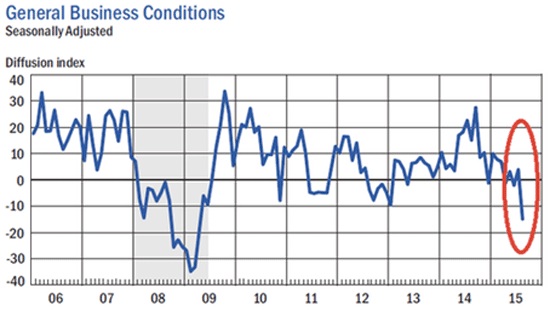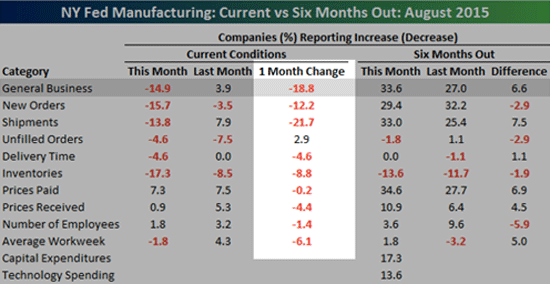There are thousands of economic and business statistics that you can look at to gauge the health of the US economy, but at the economic roots of any developed country is the prosperity of its “makers” and “takers.”
The “makers” are our factories, and the “takers” are the transportation companies delivering those goods to the stores.
I have devoted several Connecting the Dots issues (see the July 14 issue here and the August 4 issue here) to the clear warning signs that are coming from transportation companies.
This week, I’m going to focus on the “makers” because this basic building block of the American economy is looking very sick.
The US manufacturing industry has been under attack for decades from cheap overseas competition, but it is now falling like a rock.
De-industrialization Sign #1: The latest report from the New York Federal Reserve Bank shows that manufacturing activity in New York has dropped to the lowest level since 2009. Yup, just as bad as during the depths of the Financial Crisis.

The New York Fed’s Empire State general business conditions index plummeted from 3.86 in July to negative 14.92 in August. The Wall Street crowd expected the index to rise to 4.5; boy, were they wrong.

That is the largest one-month decline since November 2010, the sixth-largest monthly drop in history, the biggest miss relative to expectations since June 2011, and the crappiest reading since April 2009.

Warning signs were everywhere: eight out of nine components were down in July, with New Orders and Shipments down the most.
In the case of New Orders, it was the worst reading since November 2010, and for Shipments it was the largest one-month decline since June 2011 and the lowest reading since March 2009.
De-industrialization Sign #2: The Institute for Supply Management’s Purchasing Managers Index (PMI) for manufacturers dropped from 53.5 in June to 52.7 in July. While that isn’t horrible, the export component of the index dropped from 49.5 to 48, clear evidence that US exports are in deep trouble.
My guess is that American companies are struggling from a combination of a slowing global economy and the strength of the dollar, which makes US exports more expensive for foreign buyers.
De-industrialization Sign #3: More proof of export woes for American companies. According to Trade Stats Express, US exports are down 4.16% in the first six months of 2015.

As the above chart shows, US industrial production is slower than a snail.
De-industrialization Sign #4: Perhaps the most telling is the capacity utilization rate. I like to think of capacity utilization as the unemployment rate for American factories.
Any reading over 80% suggests strong factory growth, but anything below 80% is analogous to an 8% or 9% unemployment rate, in my book.

Capacity utilization has been dropping like a rock in 2015 and hit 78.0% in July for the industrial companies.
Opinions vary, but I consider capacity utilization to be one of the most reliable recession indicators there is. Capacity utilization won’t tell you when the stock market has topped out, but it is a very accurate gauge of overall economic health.
De-industrialization Sign #5: The US isn’t the only place whose factories are dangerously slowing down. Despite the Chinese government’s best efforts to reinvigorate its slowing economy, the latest Purchasing Managers Index (PMI) readings dropped to 47.1 in August, a 77-month low.

A figure above 50 signals growth, while anything below indicates contraction.
August, by the way, is even worse than July, which was a two-year low.
So what’s an investor to do?
Look, American factories (the “makers”) are falling into deep trouble—and when combined with the horrible fundamentals of the transportation industry (the “takers”), it is clear that our economy is showing a lot of recessionary symptoms.
Unless you do something to improve your portfolio’s immune system, you may soon find yourself at the receiving end of a visit from the Wall Street proctologist.
One way is to diversify into some of the dividend-paying, international stocks and funds in our Yield Shark portfolio—I suggest you give it a risk-free try today.

Tony Sagami
30-year market expert Tony Sagami leads the Yield Shark and Rational Bear advisories at Mauldin Economics. To learn more about Yield Shark and how it helps you maximize dividend income, click here. To learn more about Rational Bear and how you can use it to benefit from falling stocks and sectors, click here.

